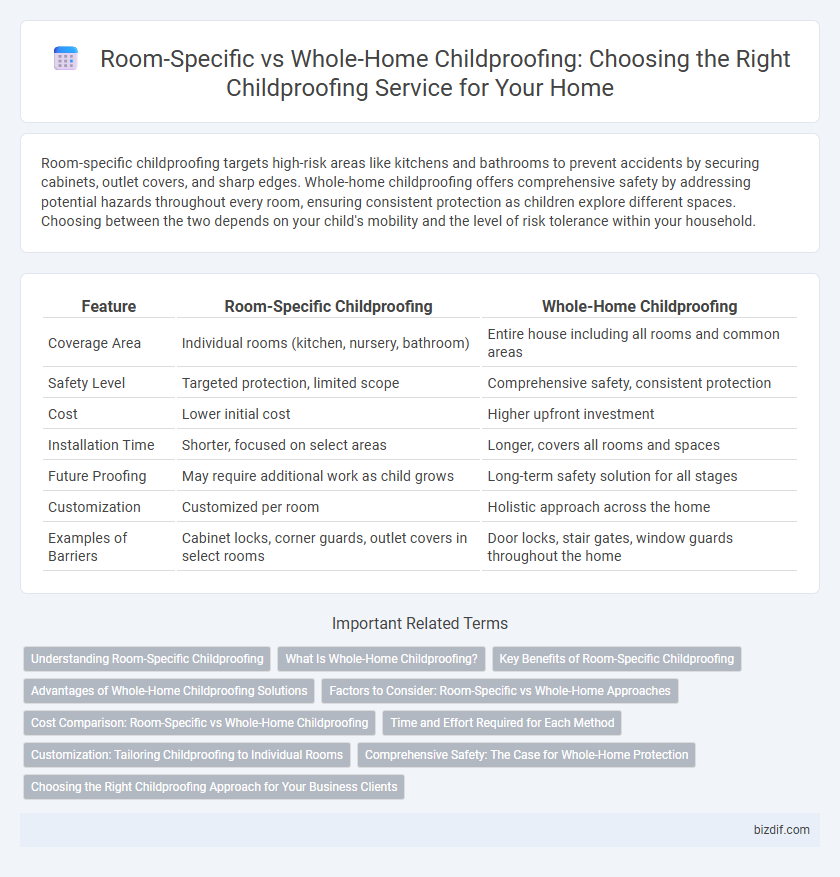Room-specific childproofing targets high-risk areas like kitchens and bathrooms to prevent accidents by securing cabinets, outlet covers, and sharp edges. Whole-home childproofing offers comprehensive safety by addressing potential hazards throughout every room, ensuring consistent protection as children explore different spaces. Choosing between the two depends on your child's mobility and the level of risk tolerance within your household.
Table of Comparison
| Feature | Room-Specific Childproofing | Whole-Home Childproofing |
|---|---|---|
| Coverage Area | Individual rooms (kitchen, nursery, bathroom) | Entire house including all rooms and common areas |
| Safety Level | Targeted protection, limited scope | Comprehensive safety, consistent protection |
| Cost | Lower initial cost | Higher upfront investment |
| Installation Time | Shorter, focused on select areas | Longer, covers all rooms and spaces |
| Future Proofing | May require additional work as child grows | Long-term safety solution for all stages |
| Customization | Customized per room | Holistic approach across the home |
| Examples of Barriers | Cabinet locks, corner guards, outlet covers in select rooms | Door locks, stair gates, window guards throughout the home |
Understanding Room-Specific Childproofing
Room-specific childproofing targets hazards unique to individual spaces, such as securing kitchen cabinets to prevent access to sharp objects and installing outlet covers in bedrooms. This focused approach allows parents to address high-risk areas effectively without investing in whole-home modifications. Tailoring safety measures by room ensures practical, manageable childproofing that directly reduces accident risks in critical zones.
What Is Whole-Home Childproofing?
Whole-home childproofing involves systematically securing every room and area in a house to create a comprehensive safe environment for children. This approach includes installing safety gates, securing furniture, locking cabinets, covering electrical outlets, and reinforcing windows throughout the entire home, rather than focusing on individual rooms. Whole-home childproofing minimizes risks by addressing hazards in all spaces, providing consistent protection and peace of mind for parents and caregivers.
Key Benefits of Room-Specific Childproofing
Room-specific childproofing targets high-risk areas like kitchens, bathrooms, and playrooms to address unique hazards with tailored safety solutions. This focused approach enhances safety by providing specialized protection such as cabinet locks, outlet covers, and corner guards that meet the specific needs of each room. It allows for efficient allocation of resources and quicker implementation, ensuring critical zones are childproofed first for immediate safety improvements.
Advantages of Whole-Home Childproofing Solutions
Whole-home childproofing solutions provide comprehensive safety by addressing hazards in every room, reducing the risk of injury throughout the entire house. This approach ensures consistent protection, eliminating unsafe areas that partial childproofing might miss, such as staircases, kitchens, and bathrooms. Investing in whole-home childproofing maximizes peace of mind for parents by creating a secure environment for children to explore freely.
Factors to Consider: Room-Specific vs Whole-Home Approaches
Room-specific childproofing targets high-risk areas like kitchens and bathrooms where hazards such as sharp objects and chemicals are prevalent, offering tailored protection that addresses the unique dangers within each room. Whole-home childproofing provides comprehensive safety measures throughout the entire residence, ensuring consistent protection by covering all potential risk zones including stairs, outlets, and furniture edges. Factors to consider include the child's mobility and habits, budget constraints, and the level of supervision available, as these influence whether a focused or broad approach best minimizes safety risks.
Cost Comparison: Room-Specific vs Whole-Home Childproofing
Room-specific childproofing typically costs less upfront as it targets high-risk areas like kitchens or nurseries, with average expenses ranging between $100 to $300 per room. Whole-home childproofing involves comprehensive safety measures throughout the entire house, often costing $1,000 to $3,000 depending on the home's size and complexity. Investing in room-specific solutions may be more budget-friendly initially, but whole-home childproofing provides extensive protection that could reduce long-term injury risks and potential healthcare costs.
Time and Effort Required for Each Method
Room-specific childproofing demands less initial time and effort since it targets high-risk areas individually, allowing focused installation of safety devices like outlet covers and cabinet locks. Whole-home childproofing requires a comprehensive assessment and implementation across every room, significantly increasing the time and labor involved to ensure consistent protection. Choosing room-specific methods often suits immediate needs, while whole-home strategies offer long-term safety but require more extensive planning and resources.
Customization: Tailoring Childproofing to Individual Rooms
Room-specific childproofing targets hazards unique to each space, such as stove knob covers in kitchens or corner guards in living rooms, ensuring precise safety measures. Whole-home childproofing provides a comprehensive approach, but customization allows for tailored solutions that address the distinct risks found in bedrooms, bathrooms, and play areas. Prioritizing room-based strategies enhances effectiveness by focusing on the individual environment's specific dangers and child's behavior patterns.
Comprehensive Safety: The Case for Whole-Home Protection
Whole-home childproofing offers comprehensive safety by addressing hazards in every room, ensuring consistent protection throughout the house. Unlike room-specific childproofing, which targets isolated areas, whole-home solutions mitigate risks like electrical outlets, sharp edges, and toxic substances universally. This approach significantly reduces the chances of accidents, providing parents with greater peace of mind and a safer environment for their children.
Choosing the Right Childproofing Approach for Your Business Clients
Room-specific childproofing targets high-risk areas such as kitchens, bathrooms, and playrooms, providing tailored safety solutions to reduce immediate hazards and improve client satisfaction. Whole-home childproofing offers comprehensive protection by addressing potential dangers throughout the entire residence, ideal for clients seeking extensive safety measures and consistent risk management. Evaluating business clients' lifestyles, property layouts, and budget constraints is essential in recommending the most effective childproofing approach to ensure optimal safety and client trust.
Room-specific childproofing vs Whole-home childproofing Infographic

 bizdif.com
bizdif.com